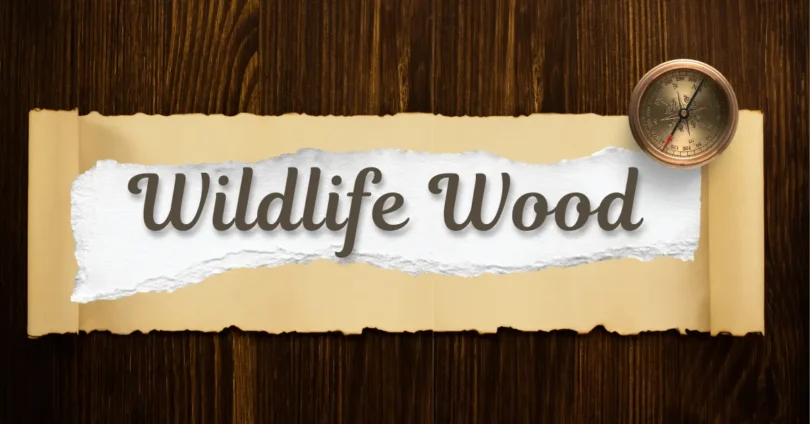Wildlife Wood is a special place where nature, animals, and trees live together in balance. It is more than just a forest; it is a safe home for birds, insects, and wild animals that depend on trees for food and shelter. Wildlife Wood also helps people by cleaning the air, keeping the land healthy, and giving us peace when we visit. Learning about Wildlife Wood is important because it teaches us how nature works and why we must protect it for future generations.
The Meaning and Concept of Wildlife Wood
Wildlife Wood means a woodland or forest area that is kept safe for animals, plants, and people to enjoy in a natural way. It is not just about cutting trees for wood; instead, it is about protecting nature while still using the forest in a responsible manner. In Wildlife Wood, animals find food and shelter, plants grow freely, and people can learn about the beauty of nature.
The concept of Wildlife Wood is based on balance. It allows us to enjoy the benefits of forests, such as clean air and fresh water, while also giving space for wildlife to live safely. Unlike ordinary forests that may be used only for wood cutting or farming, Wildlife Wood is carefully managed so that nature and humans both gain benefits without harm.
History and Origin of Wildlife Wood
The history of Wildlife Wood goes back to ancient times when people first discovered the value of forests. In the beginning, humans depended on wood for fire, shelter, and tools, but they also noticed that forests were home to many animals and plants. Early communities respected these natural areas, often treating them as sacred places where wildlife and people could live side by side.
The origin of the concept of Wildlife Wood began when people realized that cutting too many trees harmed both nature and human life. Over time, kings, rulers, and local communities started protecting certain forests to keep animals safe and to preserve the balance of the environment. In modern times, this idea grew stronger with the rise of conservation movements. Now, many countries protect woodlands as Wildlife Wood to ensure that animals, plants, and humans can continue to benefit from them for generations to come.
Importance of Wildlife Wood for Nature
Wildlife Wood plays a big role in keeping nature balanced and healthy. It gives life to animals, plants, and even humans by protecting the environment in many ways:
- Provides safe homes for animals, birds, and insects
- Helps in cleaning the air by producing fresh oxygen
- Keeps the soil strong and prevents soil erosion
- Protects rivers and lakes by saving water sources
- Supports rare and endangered plants and animals
- Balances the climate by reducing harmful gases
- Creates a natural space where different species can live together
Wildlife Wood is not just a forest; it is nature’s guardian that protects the environment and keeps life safe for the future.
Types of Wildlife Wood
Wildlife Wood is not the same everywhere. It comes in different types, each serving a special role in protecting nature and animals:
- Natural Wildlife Wood: These are forests that grow naturally without human effort. They are full of native plants, wild animals, and rare species.
- Protected Wildlife Wood: These are woodlands that governments or organizations guard carefully to stop deforestation and hunting.
- Community Wildlife Wood: Local people look after these forests. They protect them while using resources responsibly.
- Man-Made Wildlife Wood: These are woodlands created by humans through planting trees and making safe spaces for animals.
- Mixed Wildlife Wood: A combination of natural and planted areas, giving both wildlife and humans benefits.
The types of Wildlife Wood may differ, but they all share one goal protecting animals, plants, and the environment for a safer and greener planet.
Benefits of Wildlife Wood for Humans
Wildlife Wood is not only helpful for animals and plants, but it also gives many benefits to humans in daily life:
- Provides clean and fresh air for breathing
- Keeps water sources safe and healthy for drinking
- Offers wood and natural resources in a safe way
- Reduces stress and makes people feel relaxed in nature
- Creates jobs through eco-tourism and forest activities
- Helps in education and research about plants and animals
- Protects humans from natural disasters like floods and heat waves
Wildlife Wood gives humans a healthy life, useful resources, and peace of mind while also protecting the Earth for future generations.
Threats and Problems Facing Wildlife Wood
Wildlife Wood is very important, but today it faces many dangers from human actions and natural changes:
- Deforestation: Cutting too many trees for wood and land harms animals and plants.
- Climate Change: Rising temperatures and changing weather make it hard for wildlife to survive.
- Pollution: Chemicals, plastics, and smoke damage the soil, air, and water in forests.
- Urbanization: Building cities, roads, and farms takes away natural spaces for wildlife.
- Illegal Hunting: Animals living in Wildlife Wood are at risk due to poaching and hunting.
- Fires: Forest fires, both natural and man-made, destroy trees and kill wildlife.
- Overuse of Resources: Taking too much wood, plants, or water from these areas harms their balance.
The problems facing Wildlife Wood are serious, but with care and protection, humans can save these precious natural spaces for the future.
Wildlife Conservation in Woodlands
Wildlife conservation in woodlands means protecting forests and the animals, plants, and resources inside them. It is done in many ways to keep nature safe and balanced:
- Government Protection: Many forests are declared as national parks or reserves to stop hunting and tree cutting.
- Community Efforts: Local people join together to plant trees, guard forests, and use resources wisely.
- Wildlife Laws: Rules and fines are made to stop poaching, illegal logging, and land grabbing.
- Non-Government Organizations (NGOs): NGOs run awareness campaigns, plant trees, and support forest projects.
- Wildlife Sanctuaries: Special safe areas are built where animals and birds can live without harm.
- Education Programs: Schools and colleges teach children about the importance of forests and wildlife.
- Eco-Tourism: Visitors are encouraged to enjoy forests in a safe way, which also supports conservation.
Wildlife conservation in woodlands is the key to saving forests, animals, and the environment, and it needs the support of everyone.
Sustainable Use of Wildlife Wood
Sustainable use of Wildlife Wood means using forest resources in a way that meets human needs without harming nature. It focuses on balance so that forests stay healthy for future generations:
- Eco-Friendly Wood Products: Using wood carefully to make furniture and tools without wasting trees.
- Responsible Tourism: Allowing people to visit forests in a safe way that does not harm wildlife.
- Tree Planting Programs: Planting new trees whenever old ones are cut to keep the forest growing.
- Controlled Wood Cutting: Cutting only a limited number of trees to protect the natural balance.
- Use of Alternatives: Encouraging bamboo, recycled wood, and other eco-materials instead of overusing forest wood.
- Awareness Campaigns: Teaching people about the importance of saving Wildlife Wood through workshops and schools.
- Reforestation Drives: Large-scale planting of trees to replace lost woodlands and improve wildlife habitats.
Sustainable use of Wildlife Wood ensures that humans get what they need while nature and wildlife remain safe, balanced, and protected.
Famous Wildlife Woodlands Around the World
Around the world, there are many famous Wildlife Woodlands that protect animals, plants, and nature. These places are known for their beauty and importance:
- Sherwood Forest (United Kingdom): Famous for the legend of Robin Hood, this forest is rich in old oak trees and wildlife.
- Amazon Rainforest (South America): The largest rainforest in the world, home to millions of species of animals, birds, and plants.
- Sundarbans (India & Bangladesh): Known for the Royal Bengal Tiger and unique mangrove trees, this forest is a UNESCO World Heritage Site.
- Black Forest (Germany): A beautiful woodland with dense trees, rivers, and a variety of birds and wild animals.
- Daintree Rainforest (Australia): One of the oldest rainforests on Earth, full of rare plants, insects, and reptiles.
- Congo Rainforest (Africa): The second largest rainforest in the world, providing shelter to gorillas, elephants, and many other species.
Famous Wildlife Woodlands are treasures of the Earth. They are not only beautiful but also vital for protecting animals, plants, and the natural balance of life.
Future of Wildlife Wood
The future of Wildlife Wood depends on how humans care for forests today. If we protect trees, reduce pollution, and stop deforestation, these woodlands will continue to give life to animals, plants, and people. Modern technology, such as satellite monitoring and smart planting methods, is already helping in conservation.
In the future, Wildlife Wood can become stronger through eco-friendly tourism, large reforestation projects, and awareness programs for children and communities. If everyone works together, Wildlife Wood will remain a safe home for wildlife and a source of health and peace for future generations.
Common FAQs About Wildlife Wood
Some faqs of Wildlife Wood:
Can Wildlife Wood help in controlling global warming?
Yes, Wildlife Wood absorbs harmful gases like carbon dioxide and releases oxygen, which helps in reducing the effects of global warming.
How does Wildlife Wood support local communities?
It provides jobs through eco-tourism, woodcraft, and forest management while teaching people how to live in harmony with nature.
Are there medicines found in Wildlife Wood?
Yes, many plants in Wildlife Wood have natural healing properties that are used in traditional and modern medicine.
Can Wildlife Wood be created in cities?
Yes, urban forests and small community woodlands can be developed in cities to give space for wildlife and provide green areas for people.
How is technology helping to protect Wildlife Wood?
Drones, satellite mapping, and wildlife tracking devices are being used to monitor forests and stop illegal activities like tree cutting or hunting.
Conclusion
Wildlife Wood is more than just a forest; it is a living treasure that protects animals, plants, and people at the same time. It gives us clean air, fresh water, and peace of mind while also keeping the Earth balanced. Though it faces many threats like deforestation and climate change, strong conservation efforts and sustainable practices can save it.
The future of Wildlife Wood depends on how responsibly we act today. By protecting these woodlands, we are not only saving wildlife but also securing a healthier and greener world for future generations.



